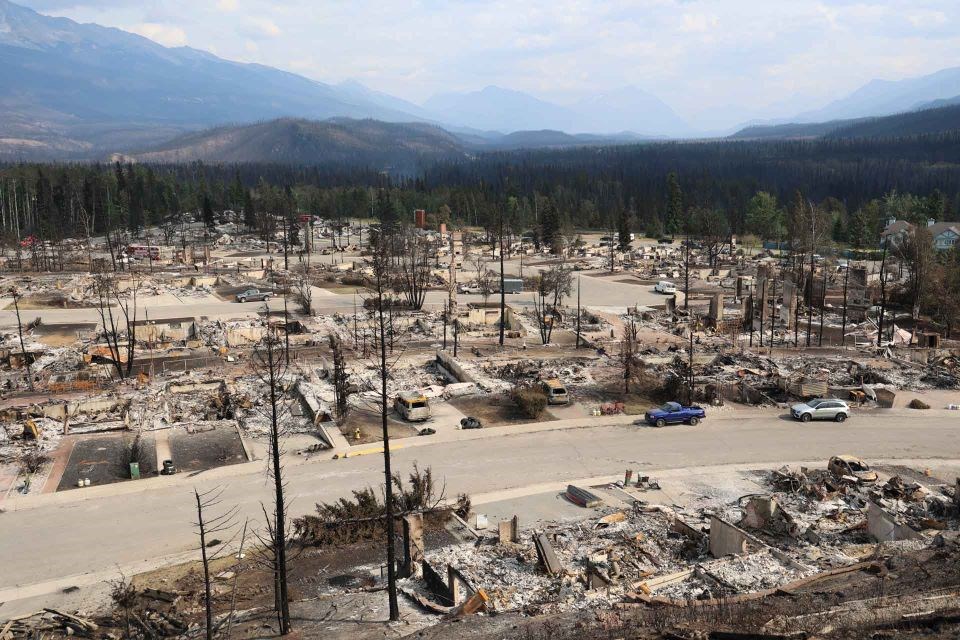As the wildfires in Jasper National Park rage on, many are naturally comparing this crisis to what happened to Fort McMurray in 2016.
Sandy Bowman, mayor of the Regional Municipality of Wood Buffalo (RMWB), which includes Fort McMurray and the surrounding area, said it was difficult to learn about what was happening to Jasper.
“I think there’s no question it brings back memories of our experience in 2016,” Bowman said to the Fitzhugh in an email.
“While our community is not defined by the 2016 wildfire, we recognize it will always be part of our story and we carry with us what happened as well as the lessons learned and improvements we have since made as a result. If there’s a community that understands what Jasper is going through, it’s us.”
Regarded as one of Canada’s worst wildfires, the 2016 Fort McMurray fire forced 80,000 people to evacuate and damaged more than 2,500 properties.
Bowman said the Jasper crisis was similar in that entire homes and buildings have been lost and an evacuation of the entire community has gone on for an extended period.
A key difference is that while fewer homes were lost during the Fort McMurray fire, it represented around 10 per cent of them.
Jasper, meanwhile, has 30 per cent of its structure damaged or destroyed, with Jasper Mayor Richard Ireland previously noting that this may not capture the full impact on residents since many of the buildings destroyed were apartments that housed dozens.
“What is also similar is the resolve and character being shown by emergency responders and those working tirelessly to protect the community and then to get people home safely as soon as possible,” Bowman said.
“Another similarity is how Albertans and people across the country are reaching out to support those that have been impacted. We will never forget how people helped us when we needed it the most.”
Bowman was able to speak with Jasper’s mayor shortly after the evacuation and had offered “any and all” support that Wood Buffalo was able to provide.
Wood Buffalo’s administration has shared lessons learned as well as re-entry, rebuild and recovery plans used back in 2016 and the following years.
Bowman noted that many conditions have to be made before Jasperites can return home, but it appeared that progress was being made.
“In terms of the next steps – whether that’s re-entry, rebuilding or what we would more broadly call recovery – it’s [a] good idea to make a focus on people the top priority,” he said.
“That means working with partners to ensure mental health and other supports are available for community members and making communication and public engagement a pillar of your approach in recovery.”
He added that while rebuilding homes was the main priority for homeowners, there should be consideration for supporting people, remediating and protecting the environment and economic recovery and support.
Officials should also look at the overall resilience, mitigation and preparedness plans for Jasper going forward.
Pointing out how some Jasperites had chosen to take bus tours of the townsite while others are waiting for the chance to see their property in a more private setting, Bowman said people process things and recover in their own way, which should be expected and encouraged.
“For those that will have lost their homes, we know that there will be challenges and ups and downs,” he added.
“There will be days and times of good news and progress, and days where things are challenging. Unfortunately, rebuilding may take longer than anticipated, and there are always complexities dealing with insurance providers, governments, contractors, all while trying to get the rest of life on track. Take things one day at a time and know there are people out there to support you.”
Through its “Show your love for Jasper” campaign, the RMWB is asking its residents to upload video messages of support and create handmade drawings for a fence banner that will hang in the Jasper rebuild areas.
“We heard from people in the community that they wanted an avenue to share messages of support, and we also thought as a Municipality it was important for people in Jasper to know we’re here for them, that we understand as much as anyone can, and that we’re thinking of them,” Bowman said.
Bowman encouraged Jasper evacuees who are feeling lonely to reach out and not be worried about getting the support they need.
“For many people and the entire community, things won’t be the same as they were before the wildfire, and it’s okay to embrace that, as hard as it can seem,” he said.
“But that doesn’t mean that the future can’t be good, or even better, even if you don’t know right now how that can be possible. You will persevere and get through this and there are a lot of people here to help you.”




